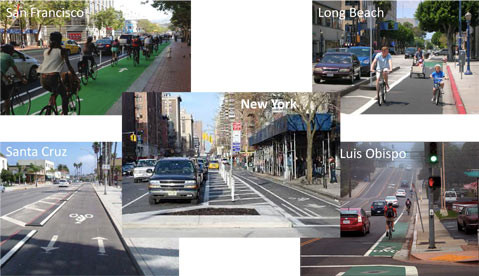The Future of Biking in Santa Barbara
Creating a New Bicycle Master Plan

This could be a banner year for biking in Santa Barbara. The city is writing its Bicycle Master Plan, setting the pace for the next decade of cycling infrastructure development. The budget for completing the plan is $220,000 and the city hopes to have it finished by late fall.
Santa Barbara was among the first cities to have a bike master plan, which it first developed in 1974. Unfortunately, in recent years we’ve fallen behind in bike infrastructure and safety. We are now ranked fourth worst for biking safety when compared to similarly sized cities. Safer bikeways are a logical goal for any bike master plan. Yet, some local leaders still balk at the suggestion of extending or improving bikeways.

Councilmember Frank Hotchkiss wrote an op-ed in which he questioned the rationale behind the push to increase biking, and he suggested that adding more bikes would impede car travel. Hotchkiss asked for comments, and he received more than 200, most of which reflected a growing local knowledge and a demand for safer streets.
Studies have shown that well-designed and integrated bike systems can actually cut travel time, even in gridlocked cities like New York. Better bikeways also decrease injuries and reduce driver stress by limiting interaction between motorists, cyclists, and pedestrians.
Allowing our transportation system to remain as it is would be a disservice to the community. Our current biking network is fragmented and inadequate, increasing stress for people driving, increasing hazards for people biking and walking, and decreasing safety for everyone.
According to Santa Barbara Bicycle Coalition Director Ed France, “There is not a single bike route in all of Santa Barbara that is contiguous. Every single bike route has gaps. In many really dangerous intersections, the bike lane just disappears.”
A complete system will require a forward-thinking outlook and a commitment to increased ridership. While Santa Barbara leaders hesitate to commit to cycling specific improvements, the language of other bike master plans is unambiguously pro-bike and serves as a reminder of what is possible.
Chicago’s plan seeks to “make bicycling an integral part of daily life in Chicago.” The plan proposes a “500-mile bikeway network, establishing a bikeway within a half-mile of every Chicago resident.”
San Diego is striving to become “a city where bicycling is a viable travel choice, particularly for trips of less than five miles,” with, “a safe and comprehensive local and regional bikeway network”
San Luis Obispo is shooting for 20 percent of trips to be taken by bike.
Thus far, Santa Barbara has shied away from any such bold declarations, perhaps due to fear of a backlash from a vocal minority decrying a war on cars. A Santa Barbara group called Cars Are Basic (CAB) has been quick to criticize city spending on biking, noting that most people drive cars and our infrastructure should reflect that.
Car travel is intrinsically inefficient. It requires vast amounts of land for parking, endless fuel supplies, and a great deal of money for the constant repair and replacement of roads.
Despite the high impact of auto travel, Ed France wants to be clear that his organization has no interest in pushing people out of their cars. “We are not trying to convert people to biking. We want people to be able to choose.”
Choice appears to be something that both CAB and the Santa Barbara Bicycle Coalition agree on. CAB’s mission statement says, “The right to choose the mode of transportation is at the core of a free society.” When contacted, CAB representatives declined to comment.
France believes that many residents want to ride more, but the lack of safe routes deters them. “People deserve the freedom to choose how to get around, but we haven’t given them the safety to do that.”
The city is seeking abundant evidence that people are interested in an alternative to car travel before it decides on specific projects to fund. Mobility Coordinator Peter Brown says gathering this information is vital to the process. “The City Council has wanted to develop a plan based on what the community is looking for.” To that end, the city has created a website with an online survey and an interactive map, and will be hosting neighborhood summits to discuss more localized concerns.
“We’ve gotten a lot of positive feedback,” says Brown, “close to 500 people have taken the online survey so far, and we’ve had two outreach roadshows.” Despite initial concerns that most respondents would be cycling advocates, feedback has come from a more diverse group. “We’re hearing from a lot of different folks, automobile advocates, the cycling community, and local business owners. We’ve asked people to identify themselves in the survey, and at last check 60 percent of the survey respondents had identified themselves as drivers.”
France says Bicycle Coalition membership is strong and steadily growing, with almost 1,000 members who “want the roadways to feel safe. Not just for them but for their kids and their neighbors.”
A small percent of residents will continue to bike no matter how treacherous the roads. Another small percent will abhor any development that isn’t auto-centric. Most of us fall somewhere in the middle. Devising a plan that moves traffic smoothly and safely over the long haul should be the goal. Bridging gaps in the bike network would be a step toward better travel for everyone.
What are you hoping to see included in Santa Barbara’s Bicycle Master Plan? Protected bike lanes? Preservation of on street parking? The city could benefit from your feedback. Attend a meeting, take the survey, write a council member. Doing any one of these things will help create safer streets for Santa Barbara.
Five neighborhood summits take place in May:
Eastside Summit (En Español), May 16, 10 a.m.-noon, Franklin Elementary, 1111 East Mason Street
Westside Summit (En Español), May 16, 2-4 p.m., Harding Elementary, 1625 Robbins Street
Uptown Summit, May 18, 6-8 p.m., Peabody Elementary, 3018 Calle Noguera
Downtown Summit, May 19, 6-8 p.m., S.B. Public Library, 40 East Anapamu Street
Mesa Summit, May 20, 6-8 p.m., Washington Elementary, 290 Lighthouse Road



